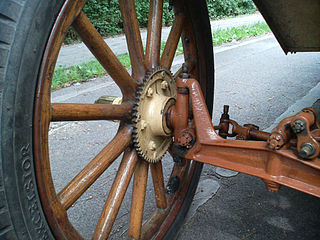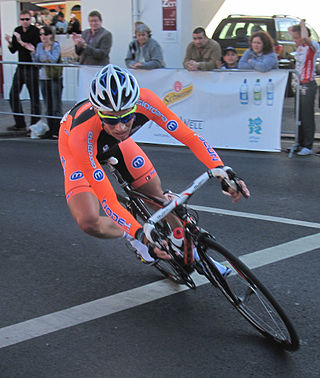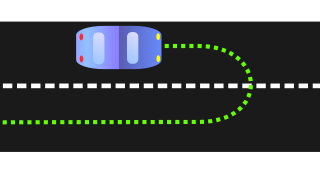
A tire or tyre is a ring-shaped component that surrounds a wheel's rim to transfer a vehicle's load from the axle through the wheel to the ground and to provide traction on the surface over which the wheel travels. Most tires, such as those for automobiles and bicycles, are pneumatically inflated structures, providing a flexible cushion that absorbs shock as the tire rolls over rough features on the surface. Tires provide a footprint, called a contact patch, designed to match the vehicle's weight and the bearing on the surface that it rolls over by exerting a pressure that will avoid deforming the surface.

A tricycle, sometimes abbreviated to trike, is a human-powered three-wheeled vehicle.
Vehicle dynamics is the study of vehicle motion, e.g., how a vehicle's forward movement changes in response to driver inputs, propulsion system outputs, ambient conditions, air/surface/water conditions, etc. Vehicle dynamics is a part of engineering primarily based on classical mechanics. It may be applied for motorized vehicles, bicycles and motorcycles, aircraft, and watercraft.

The MacPherson strut is a type of automotive suspension system that uses the top of a telescopic damper as the upper steering pivot. It is widely used in the front suspension of modern vehicles. The name comes from American automotive engineer Earle S. MacPherson, who invented and developed the design.

The kingpin is the main pivot in the steering mechanism of a car or other vehicle.

Steering is the control of the direction of motion or the components that enable its control. Steering is achieved through various arrangements, among them ailerons for airplanes, rudders for boats, tilting rotors for helicopters, and many more.
Understeer and oversteer are vehicle dynamics terms used to describe the sensitivity of the vehicle to changes in steering angle associated with changes in lateral acceleration. This sensitivity is defined for a level road for a given steady state operating condition by the Society of Automotive Engineers (SAE) in document J670 and by the International Organization for Standardization (ISO) in document 8855. Whether the vehicle is understeer or oversteer depends on the rate of change of the understeer angle. The Understeer Angle is the amount of additional steering that must be added in any given steady-state maneuver beyond the Ackermann steer angle. The Ackermann Steer Angle is the steer angle at which the vehicle would travel about a curve when there is no lateral acceleration required.

Parallel parking is a method of parking a vehicle parallel to the road, in line with other parked vehicles. Parallel parking usually requires initially driving slightly past the parking space, parallel to the parked vehicle in front of that space, keeping a safe distance, then followed by reversing into that space. Subsequent position adjustment may require the use of forward and reverse gears.
Tire rotation is the practice of moving the wheels and tires of an automobile from one position to another, to ensure even tire wear. Even tire wear extends the useful life of a set of tires, but the value of this is disputed.
Automobile handling and vehicle handling are descriptions of the way a wheeled vehicle responds and reacts to the inputs of a driver, as well as how it moves along a track or road. It is commonly judged by how a vehicle performs particularly during cornering, acceleration, and braking as well as on the vehicle's directional stability when moving in steady state condition. Numerous factors affect handling

In automotive engineering, toe, also known as tracking, is the symmetric angle that each wheel makes with the longitudinal axis of the vehicle, as a function of static geometry, and kinematic and compliant effects. This can be contrasted with steer, which is the antisymmetric angle, i.e. both wheels point to the left or right, in parallel (roughly). Negative toe, or toe out, is the front of the wheel pointing away from the centreline of the vehicle. Positive toe, or toe in, is the front of the wheel pointing towards the centreline of the vehicle. Historically, and still commonly in the United States, toe was specified as the linear difference of the distance between the two front-facing and rear-facing tire centerlines at the outer diameter and axle-height; since the toe angle in that case depends on the tire diameter, the linear dimension toe specification for a particular vehicle is for specified tires.

A three-wheeler is a vehicle with three wheels. Some are motorized tricycles, which may be legally classed as motorcycles, while others are tricycles without a motor, some of which are human-powered vehicles and animal-powered vehicles.

Wheel alignment, which is sometimes referred to as breaking or tracking, is part of standard automobile maintenance that consists of adjusting the angles of wheels to the car manufacturer specifications. The purpose of these adjustments is to reduce tire wear and to ensure that vehicle travel is straight and true. Alignment angles can also be altered beyond the maker's specifications to obtain a specific handling characteristic. Motorsport and off-road applications may call for angles to be adjusted well beyond normal, for a variety of reasons.
Traction, traction force or tractive force is a force used to generate motion between a body and a tangential surface, through the use of either dry friction or shear force. It has important applications in vehicles, as in tractive effort.

A beam axle, rigid axle or solid axle is a dependent suspension design in which a set of wheels is connected laterally by a single beam or shaft. Beam axles were once commonly used at the rear wheels of a vehicle, but historically they have also been used as front axles in four-wheel-drive vehicles. In most automobiles, beam axles have been replaced with front (IFS) and rear independent suspensions (IRS).

Bicycle and motorcycle dynamics is the science of the motion of bicycles and motorcycles and their components, due to the forces acting on them. Dynamics falls under a branch of physics known as classical mechanics. Bike motions of interest include balancing, steering, braking, accelerating, suspension activation, and vibration. The study of these motions began in the late 19th century and continues today.

The turning radius of a vehicle defines the minimum dimension of available space required for that vehicle to make a semi-circular U-turn without skidding. The Oxford English Dictionary describes turning circle as "the smallest circle within which a ship, motor vehicle, etc., can be turned round completely". The term thus refers to a theoretical minimal circle in which for example an aeroplane, a ground vehicle or a watercraft can be turned around.
Clutch control refers to the act of controlling the speed of a vehicle with a manual transmission by partially engaging the clutch plate, using the clutch pedal instead of the accelerator pedal. The purpose of a clutch is in part to allow such control; in particular, a clutch provides transfer of torque between shafts spinning at different speeds. In the extreme, clutch control is used in performance driving, such as starting from a dead stop with the engine producing maximum torque at high RPM.
The scrub radius is the distance in front view between the king pin axis and the center of the contact patch of the wheel, where both would theoretically touch the road. It can be positive, negative or zero.
In automotive engineering the electronic differential is a form of differential, which provides the required torque for each driving wheel and allows different wheel speeds. It is used in place of the mechanical differential in multi-drive systems. When cornering, the inner and outer wheels rotate at different speeds, because the inner wheels describe a smaller turning radius. The electronic differential uses the steering wheel command signal and the motor speed signals to control the power to each wheel so that all wheels are supplied with the torque they need.











